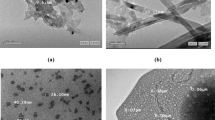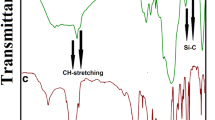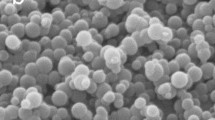Abstract
Poly(2-hydroxyethyl methacrylate-co-N-methacryloyl-(l)-glutamic acid) p(HEMA–MAGA) nanospheres have been synthesized, characterized, and used for the adsorption of Cd2+ ions from aqueous solutions. Nanospheres were prepared by surfactant free emulsion polymerization. The p(HEMA–MAGA) nanospheres were characterized by SEM, FTIR, zeta size, and elemental analysis. The specific surface area of nanospheres was found to be 1,779 m2/g. According to zeta size analysis results, average size of nanospheres is 147.3 nm with poly-dispersity index of 0.200. The goal of this study was to evaluate the adsorption performance of p(HEMA–MAGA) nanospheres for Cd2+ ions from aqueous solutions by a series of batch experiments. The Cd2+ concentration was determined by inductively coupled plasma-optical emission spectrometer. Equilibrium sorption experiments indicated a Cd2+ uptake capacity of 44.2 mg g−1 at pH 4.0 at 25 °C. The adsorption of Cd2+ ions increased with increasing pH and reached a plateau value at around pH 4.0. The data were successfully modeled with a Langmuir equation. A series of kinetics experiments was then carried out and a pseudo-second order equation was used to fit the experimental data. Desorption experiments which were carried out with nitric acid showed that the p(HEMA–MAGA) nanospheres could be reused without significant losses of their initial properties in consecutive adsorption and elution operations.











Similar content being viewed by others
References
Arpa Ç, Bereli N, Özdil E, Bektaş S, Denizli A (2010) Reactive green HE-4BD functionalized supermacroporous poly(hydroxyethyl methacrylate) cryogel for heavy metal removal. J Appl Polym Sci 118:2208–2215
Badruddoza AZM, Shawon ZBZ, Daniel TWJ, Hidajat K, Uddin MS (2013) Fe3O4/cyclodextrin polymer nanocomposites for selective heavy metals removal from industrial wastewater. Carbohydr Polym 91:322–332
Bangs LB (1987) Uniform latex particles. Seradyn Inc. Seragen diagnostics, Indianapolis
Bhattacharyya MH, Wilson AK, Rajan SS, Jonah M (2000) Biochemical pathways in cadmium toxicity. In: Zalups RK, Koropatnick J (eds) Molecular biology and toxicology of metals. Taylor and Francis, London, pp 34–74
Bosch X (2003) Cadmium cuts two ways: the heavy metal mutates DNA, and then prevents cells from repairing the damage. Science 609:1–11
Deng JH, Zhang XR, Zeng GM, Gong JL, Niu QY, Liang J (2013) Simultaneous removal of Cd(II) and ionic dyes from aqueous solution using magnetic graphene oxide nanocomposite as an adsorbent. Chem Eng J 226:189–200
Denizli A, Sanli N, Garipcan B, Patir S, Alsancak G (2004) Methacryloylamidoglutamic acid incorporated porous poly(methylmethacrylate) beads for heavy-metal removal. Ind Eng Chem Res 43:6095–6101
Durukan İ, Şahin ÇA, Şatıroğlu N, Bektaş S (2011) Determination of iron and copper in food samples by flow injection cloud point extraction flame atomic absorption spectrometry. Microchem J 99:159–163
Eren E, Gümüş H, Özbay N (2010) Equilibrium and thermodynamic studies of Cu(II) removal by iron oxide modified sepiolite. Desalination 262:43–49
Esen C, Andaç M, Bereli N, Say R, Henden E, Denizli A (2009) Highly selective ion-imprinted particles for solid-phase extraction of Pb2+ ions. Mater Sci Eng C 29:2464–2470
Fowler BA (2009) Monitoring of human populations for early markers of cadmium toxicity: a review. Toxicol Appl Pharm 238:294–300
Freundlich HMF (1906) über die adsorption in lösungen. Zeitschrift für Physikalische Chemie (leipzig) 57A:385–470
Goering PL, Waalkes MP, Klaassen CD (1995) Toxicology of cadmium. In: Goyer RA, Cherian MG (eds) Handbook of experimental pharmacology, vol 115. Toxicology of metals-biochemical aspects. Springer, Berlin, pp 189–214
Gupta VK, Nayak A (2012) Cadmium removal and recovery from aqueous solutions by novel adsorbents prepared from orange peel and Fe2O3 nanoparticles. Chem Eng J 180:81–90
He Q, Hu Z, Jiang Y, Chang X, Tu Z, Zhang L (2010) Preconcentration of Cu(II), Fe(III) and Pb(II) with 2-(2-aminoethylamino)-methyl)phenol-functionalized activated carbon followed by ICP-OES determination. J Hazard Mater 175:710–714
Ho YS, McKay G (1998) Sorption of dye from aqueous solution by peat. Chem Eng J 70:115–124
Huang Z, Wu Q, Liu S, Liu T, Zhang B (2013) A novel biodegradable β-cyclodextrin-based hydrogel for the removal of heavy metal ions. Carbohydr Polym 97:496–501
Järup L, Åkesson A (2009) Current status of cadmium as an environmental health problem: a review. Toxicol Appl Pharm 238:201–208
Kalburcu T, Öztürk N, Tüzmen N, Akgöl S, Denizli A (2014) Cholesterol removal onto the different hydrophobic nanospheres: a comparison study. J Ind Eng Chem 20:153–159
Lagergren S (1898) Zur theorie der sogenannten adsorption geloster Stoffe. Kungliga Svenska Vetenskapsakademiens, Handlingar 24:1–39
Langmuir I (1918) The adsorption of gases on plane surfaces of glass, mica and platinum. J Am Chem Soc 40:1361–1403
Li YH, Wang S, Luan Z, Ding J, Xu C, Wu D (2003) Adsorption of cadmium(II) from aqueous solution by surface oxidized carbon nanotubes. Carbon 41:1057–1062
Li ZC, Fan HT, Zhang Y, Chen MX, Yu ZY, Cao XQ, Sun T (2011) Cd(II)-imprinted polymer sorbents prepared by combination of surface imprinting technique with hydrothermal assisted sol–gel process for selective removal of cadmium(II) from aqueous solution. Chem Eng J 171:703–710
Madhava Rao M, Ramesh A, Purna Chandra Rao G, Seshaiah K (2006) Removal of copper and cadmium from the aqueous solutions by activated carbon derived from Ceiba pentandra hulls. J Hazard Mater 129:123–129
Min SH, Han JS, Shin EW, Park JK (2004) Improvement of cadmium ion removal by base treatment of juniper fiber. Water Res 38:1289–1295
Mohan D, Singh KP (2002) Single- and multi-component adsorption of cadmium and zinc using activated carbon derived from bagasse-an agricultural waste. Water Res 36:2304–2318
Munagapati VS, Yarramuthi V, Nadavala SK, Alla SR, Abburi K (2010) Biosorption of Cu(II), Cd(II) and Pb(II) by acacia leucocephala bark powder: kinetics, equilibrium and thermodynamics. Chem Eng J 157:357–365
Murray RK, Granner DK, Mayes PA, Rodwell VW (2003) Harper’s illustrated biochemistry, 28th edn. Lange Medical Books/McGraw-Hill Companies, New York
Nabid MR, Sedghi R, Bagheri A, Behbahani M, Taghizadeh M, Oskooie HA, Heravi MM (2012) Preparation and application of poly(2-amino thiophenol)/MWCNTs nanocomposite for adsorption and separation of cadmium and lead ions via solid phase extraction. J Hazard Mater 204:93–100
Nordberg GF, Herber RFM, Alessio L (Eds) (1992) Cadmium in the human environment: toxicity and carcinogenicity. International Agency for Research on Cancer, Lyon
Ossman ME, Mansour MS (2013) Removal of Cd(II) ion from wastewater by adsorption onto treated old newspaper: kinetic modeling and isotherm studies. Int J Ind Chem 4:13
Prasad K, Gopikrishna P, Kala R, Prasada Rao T, Naidu GRK (2006) Solid phase extraction vis-`a-vis coprecipitation preconcentration of cadmium and lead from soils onto 5,7-dibromoquinoline-8-ol embedded benzophenone and determination by FAAS. Talanta 69:938–945
Saeed A, Iqbal M, Holl WH (2009) Kinetics, equilibrium and mechanism of Cd2+ removal from aqueous solution by mungbean husk. J Hazard Mater 168:1467–1475
Say R, Garipcan B, Emir S, Patır S, Denizli A (2002) Preparation and characterization of the newly synthesized metal-complexing-ligand N-methacryloylhistidine having PHEMA beads for heavy metal removal from aqueous solutions. Macromol Mater Eng 287:539–545
Silva MF, Hechenleitner AAW, de Fernandes Oliviera DM, Agüeros M, Penalva R, Irache JM, Pineda EAG (2013) Optimization of maghemite-loaded PLGA nanospheres for biomedical applications. Eur J Pharm Sci 49:343–351
Templeton DM, Liu Y (2010) Multiple roles of cadmium in cell death and survival: a mini review. Chem Biol Interact 188:267–275
Terashima M, Oka N, Sei T, Yoshida H (2002) Adsorption of cadmium ion and gallium ion to immobilized metallothionein fusion protein. Biotechnol Progr 18:1318–1323
Thu PTT, Thanh TT, Phi HN, Kim SJ, Vo V (2010) Adsorption of lead from water by thiol-functionalized SBA-15 silicas. J Mater Sci 45:2952–2957
Türkmen D, Yilmaz E, Öztürk N, Akgöl S, Denizli A (2009) Poly(hydroxyethyl methacrylate) nanobeads containing imidazole groups for removal of Cu(II) ions. Mater Sci Eng C 29:2072–2078
Uygun DA, Şenay RH, Türkcan C, Akgöl S, Denizli A (2012) Metal-chelating nanopolymers for antibody purification from human plasma. Appl Biochem Biotechnol 168:1528–1539
Uygun M, Feyzioğlu E, Özçalışkan E, Caka M, Ergen A, Akgöl S, Denizli A (2013) New generation ion-imprinted nanocarrier for removal of Cr(VI) from wastewater. J Nanopart Res 15(1833):1–11
Wu S, Zhang W, Jia S, Liu Y, Ran J, Ren H, Hou J (2013) Novel pathway for the synthesis of monodisperse MCM-41 nanospheres with different particle size distributions. Mater Lett 98:138–141
Author information
Authors and Affiliations
Corresponding author
Rights and permissions
About this article
Cite this article
Esen, C., Şenay, R.H., Feyzioğlu, E. et al. Poly(hydroxyethyl methacrylate-co-methacryloylglutamic acid) nanospheres for adsorption of Cd2+ ions from aqueous solutions. J Nanopart Res 16, 2255 (2014). https://doi.org/10.1007/s11051-014-2255-z
Received:
Accepted:
Published:
DOI: https://doi.org/10.1007/s11051-014-2255-z




